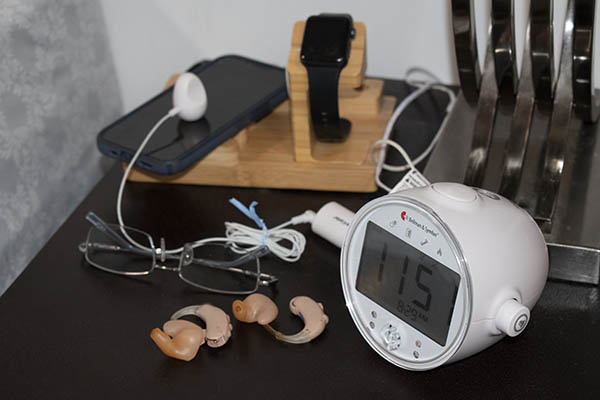When Silence Feels Unsafe: Nighttime Fire Safety for People with Hearing Loss
The Fear Behind a Good Night’s Sleep
For many people who wear hearing aids, bedtime brings a quiet that feels uneasy.
When you take your hearing aids out, you also take away your ability to hear alarms, knocks, or even your phone.
It’s common to lie in bed wondering:
“What if a smoke alarm goes off while I’m sleeping?”
That fear often leads to restless nights, leaving hearing aid users exhausted and anxious. But here’s the good news: you don’t have to sleep in fear.
October is Fire Safety Month, and it’s the perfect time to learn about fire safety for hearing loss — the tools and habits that help you rest easy, knowing you’ll still be alerted if something happens.
Why Regular Smoke Alarms Aren’t Enough
Traditional smoke alarms rely on loud, high-pitched tones — the exact range that’s hardest to hear for most people with hearing loss.
And here’s something many people don’t realize: smoke alarms are rarely located inside bedrooms.
They’re usually installed in hallways or common areas just outside the door.
Even for people with normal hearing, those alarms can be difficult to hear through walls or closed doors.
For someone with hearing loss — especially when hearing aids are out and you’re in deep sleep — it’s unlikely you’ll notice the alarm at all.
That delay can cost precious seconds in an emergency, but there’s a better way to stay protected.
Fire Safety Tools That Work Without Hearing Aids
A great option for nighttime safety is a smoke alarm system that works for everyone in the household.
How the System Works
These smoke alarms sound loudly like a standard unit — so hearing family members are alerted — and at the same time, they send a wireless signal to a bedside alarm clock connected to a bed shaker.
-
When smoke is detected, the alarm sounds throughout the home.
-
The clock beside your bed receives a signal instantly.
-
The clock activates a bed shaker, a small device that sits under your pillow or mattress and vibrates strongly to wake you up.
This dual-purpose setup protects both hearing and hard of hearing family members, whether they hear the sound or feel the vibration.
It’s reliable, easy to use, and works even when your hearing aids are off.
Many models can also connect to doorbells or phones later on, using the same clock and bed shaker as the central alert hub.
Two Extra Tips for Even Greater Safety
- Keep your hearing aids close at hand.
Place your hearing aids in their charger or storage case on your bedside table every night.
That way, they’re easy to find and put in quickly if you need to communicate or move to safety. - Register your hearing loss with local emergency services.
Many communities allow you to add notes to their Computer-Aided Dispatch (CAD) system or special needs registry.
When first responders know someone in the home has hearing loss, they can use visual or tactile signals, or communicate by text during emergencies.
These small steps help emergency teams help you faster — and give you peace of mind.
Rest Easy, Not Restless
Better safety means better sleep.
When you know your alarm system will alert you — by sound and vibration — your mind can finally relax.
That calm helps you sleep deeper, think clearer, and feel more confident about removing your hearing aids at night.
You deserve to feel safe — and a connected system can make that happen.
A Simple October Goal
This month, add one connected fire safety system to your home.
A smoke alarm that also signals a vibrating alarm clock with a bed shaker is one of the simplest ways to improve fire safety for hearing loss and protect your family while you sleep.
Once it’s in place, you can rest easy knowing you’ll wake up if something happens — even without your hearing aids.
Next Step: Explore Recommended Systems in the TLC Resource Guide
You can find my recommended vibrating alarm clock systems — designed to work directly with compatible smoke alarms — in the
These are the same systems I demonstrate in my trainings and personally recommend for nighttime safety.
Visit the Resource Guide to learn more, compare models, and find the setup that’s right for your home.
Make this Fire Safety Month the one where you finally sleep safe and sound.
Take the Next Step Toward Safer Nights
Ready to sleep soundly knowing you’ll wake up if something happens?
Visit the Hearing Tools section of the TLC Resource Guide to explore reliable, easy-to-use fire safety systems for people with hearing loss.
You’ll find my top picks for vibrating alarm clocks and bed shaker setups that help you stay safe — even when your hearing aids are off.

